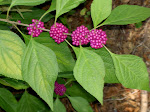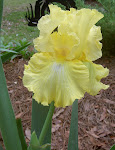 -and they have come to me in recent years. It is a gift that I treasure above most others.
-and they have come to me in recent years. It is a gift that I treasure above most others.My sister has always had the traveling bug and Panama is one of the places that she has revisted in the last couple of years. Since she knew of my passion for molas, she sent me several. One of which I decided to use as a new cover for a stool in my studio. You can see here the before and after. This is typical of the newer molas that are now being produced. They are generally appliqued in the manner of our needleturn method and have a more sophisticated appearance than earlier molas.
is one of the places that she has revisted in the last couple of years. Since she knew of my passion for molas, she sent me several. One of which I decided to use as a new cover for a stool in my studio. You can see here the before and after. This is typical of the newer molas that are now being produced. They are generally appliqued in the manner of our needleturn method and have a more sophisticated appearance than earlier molas.
 is one of the places that she has revisted in the last couple of years. Since she knew of my passion for molas, she sent me several. One of which I decided to use as a new cover for a stool in my studio. You can see here the before and after. This is typical of the newer molas that are now being produced. They are generally appliqued in the manner of our needleturn method and have a more sophisticated appearance than earlier molas.
is one of the places that she has revisted in the last couple of years. Since she knew of my passion for molas, she sent me several. One of which I decided to use as a new cover for a stool in my studio. You can see here the before and after. This is typical of the newer molas that are now being produced. They are generally appliqued in the manner of our needleturn method and have a more sophisticated appearance than earlier molas.These are some examples of older molas--at least 30 years old--maybe more. There is a lot of reverse applique on these and the themes are quite diferent from the more recent work. One of the things that I have really enjoyed with some of the older pieces is they way in  which the Indians looked at life around them and in
which the Indians looked at life around them and in terpreted it in fabric. It can be seen in this example that seems to be a beer label. The maker was spelling out the word "cervesa" but obviously ran out of room before she got to the "a." I have others that relate to political campaigns and helicopters flying overhead. And they would have seen many helicopters most likely because the United States still was in charge of the Canal Zone at that time.
terpreted it in fabric. It can be seen in this example that seems to be a beer label. The maker was spelling out the word "cervesa" but obviously ran out of room before she got to the "a." I have others that relate to political campaigns and helicopters flying overhead. And they would have seen many helicopters most likely because the United States still was in charge of the Canal Zone at that time.
 which the Indians looked at life around them and in
which the Indians looked at life around them and in terpreted it in fabric. It can be seen in this example that seems to be a beer label. The maker was spelling out the word "cervesa" but obviously ran out of room before she got to the "a." I have others that relate to political campaigns and helicopters flying overhead. And they would have seen many helicopters most likely because the United States still was in charge of the Canal Zone at that time.
terpreted it in fabric. It can be seen in this example that seems to be a beer label. The maker was spelling out the word "cervesa" but obviously ran out of room before she got to the "a." I have others that relate to political campaigns and helicopters flying overhead. And they would have seen many helicopters most likely because the United States still was in charge of the Canal Zone at that time. So I suppose that these molas were a true example of folk art at its finest and I'm glad that they are still being made today even though the style and emph asis may have changed through the years. And there are also some modern American quilters who are including this same type of applique in their work. I'm glad because I think it is joyful and celebratory-- both of the past and the present.
asis may have changed through the years. And there are also some modern American quilters who are including this same type of applique in their work. I'm glad because I think it is joyful and celebratory-- both of the past and the present.
 asis may have changed through the years. And there are also some modern American quilters who are including this same type of applique in their work. I'm glad because I think it is joyful and celebratory-- both of the past and the present.
asis may have changed through the years. And there are also some modern American quilters who are including this same type of applique in their work. I'm glad because I think it is joyful and celebratory-- both of the past and the present.








2 comments:
Hi, Judy
I've always wondered what the molas were used for - were they simply decorative items or did they have functionality also? The colors are so vibrant - do they dye their own fabrics?
Molas are mostly for decoration--I think. Almost all of mine are suitable for framing and hanging on the wall. However, I HAVE seen many articles of clothing made from them also. My mother had a long caftan-type dress with the yoke made with a mola. I really don't know about the origination of the fabric. I guess I need to research that!
Post a Comment